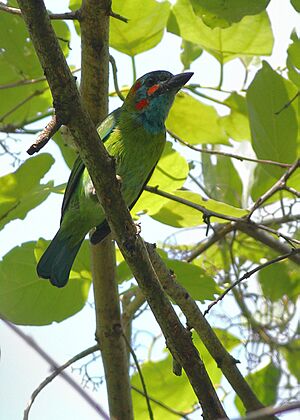Blue-eared barbet facts for kids
Quick facts for kids Blue-eared barbet |
|
|---|---|
 |
|
| Blue-eared barbet in Manas National Park | |
| Conservation status | |
| Scientific classification | |
| Genus: |
Psilopogon
|
| Species: |
cyanotis
|
| Synonyms | |
|
Megalaima cyanotis |
|
The blue-eared barbet (Psilopogon cyanotis) is a colorful bird found in mainland Southeast Asia. It belongs to the Megalaimidae family, which includes other barbet species. This bird is quite common across a large area. Because there are so many of them, they are listed as "Least Concern" on the IUCN Red List. This means they are not currently in danger of disappearing.
Contents
What Does the Blue-Eared Barbet Look Like?
The blue-eared barbet is a small, plump bird. It is about 16 to 17 centimeters (about 6 to 7 inches) long. Its body is mostly bright green. It has special crimson (deep red) spots on its cheeks. Its throat and the feathers covering its ears are a beautiful blue-green color, like the sea. There is also a black stripe that goes across its chest.
This bird has a short neck, a large head, and a short tail. Its beak is dark. You can tell the adult male apart because he has a black forehead. The female's head colors are a bit softer. Her red and blue patches might look more orange. Young blue-eared barbets have a green head. They only have a little bit of blue on their ear feathers and throat.
What Sounds Do Blue-Eared Barbets Make?
The male blue-eared barbet makes a loud call to protect its home. It sounds like a repeated "ko-turr." They also make a whistling sound. Some people say it sounds like a "policeman whistle."
Where Do Blue-Eared Barbets Live?
Blue-eared barbets live in the hills of eastern Nepal. Their home range stretches through northeast India and goes all the way to southern Thailand and Indochina. They prefer to live in areas with shrubs and forests. You can find them in places up to 1,600 meters (about 5,250 feet) high. These birds build their nests inside holes in trees.
How Are Blue-Eared Barbets Classified?
The first scientific name for this bird was Bucco cyanotis. This name was given by a scientist named Edward Blyth in 1847. He described a barbet he found in the Arakan area. Over time, scientists have used different names for Asian barbets. For example, Psilopogon was suggested in 1836. Megalaima was another name used in 1849.
Scientists group animals into different categories. This helps them understand how species are related. For the blue-eared barbet, three main types (called subspecies) are recognized:
- P. c. cyanotis: These barbets live in southeastern Nepal, Bangladesh, northeast India, Myanmar, northern Thailand, and southern China.
- P. c. orientalis: You can find these in eastern Thailand, Cambodia, Laos, and Vietnam.
- P. c. stuarti: These barbets live in peninsular Thailand.



